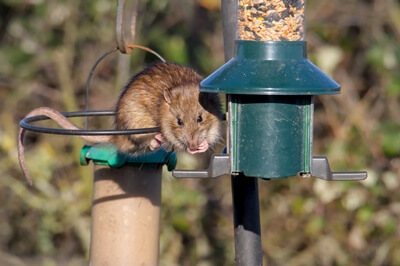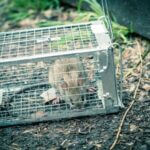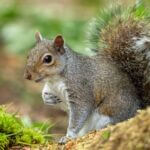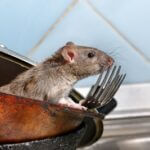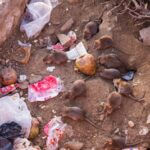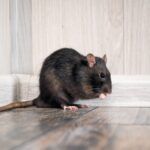Bird feeding is an enjoyable pastime if you live in an area with plenty of wildlife. With feeders, stands, and platforms, you can attract a range of breeds to your yard, adding diversity to your area.
Unfortunately, feeding birds can also attract rats, which may scare off birds, steal food, nest in your yard, and even infest your home. So, many people stop their bird-feeding hobby.
There are ways to deter rats from your bird feeders and protect your home.
Does Feeding Birds Attract Rats?
Rats are opportunistic feeders; their sense of smell allows them to detect food from miles away.
Consequently, leaving bird seed, bread, fat balls, or open water sources in easily accessible areas will draw the attention of rats and mice.
Birds drop crumbs and seeds on the ground as they eat, making spending time around bird feeders an ideal pastime for rats. Since rats aren’t picky eaters, they’ll consume whatever they find.
How Can I Feed the Birds Without Attracting Rats?
There are ways to feed birds and avoid attracting rats to your yard:
1/ Make Your Yard Less Inviting for Rats
Bird food will always lure rodents, but you can remove the other benefits to rats. Rats will seek shelter, water, warmth, and other food sources.
By removing these factors, rats will only have access to bird feed, which may not sustain their population.
Remove Other Food Sources
Clear out waste in your yards, such as pet feces, a compost pile, or dead piles of leaves or grass. If you keep pet food outdoors, take it inside or place it in a tightly sealed container.
If you have tins of damaged or dented food, throw them out, as rats can access the contents.
Keep any garbage cans tightly sealed and avoid leaving trash outside where rats can access them.
Tidy Up Garages or Sheds
Rats love hiding inside garages or underneath sheds since these areas experience little human activity.
They’re warm during the winter and cool during the summer, protecting against rain and wind. This gives rats various hiding places and new materials to chew and make into nests.
Tidy up your shed or garage by rearranging all the items to check for rats or nests.
If none are found, transfer any stored items into more secure containers, stack boxes in a way that provides fewer hiding places, and throw out any materials you don’t need.
Seal Possible Entry Points
According to Neglected Tropical Diseases, rats are more likely to enter a home with structural defects.
A rat will sneak through any holes or cracks. So, you must regularly inspect your property and seal off any openings that rodents can use to gain access.
Remove Water Sources
Rats need water to survive, so they seek this important resource. While a bird bath, a water foundation, or a small pond may be lovely in your backyard, they’ll be a haven for rats.
If you have a constant rat problem, consider removing these fixtures or adding deterrents. This may include surrounding them with rat-specific bait traps or plants like:
- Onions
- Rosemary
- Lavender
- Garlic
- Black pepper
- Daffodils
Avoid leaving pet water bowls out in the open, especially at night, since rats are more active when it’s dark. If you have leaking faucets, water pipes, or hoses, repair them to keep these areas dry.
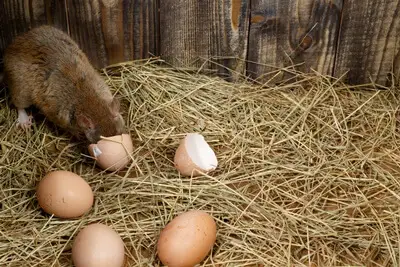
2/ Right Type of Feeders
To avoid rats, never feed birds by throwing seeds on the ground or laying food on a platform. Instead, purchase rat-proof feeders to keep out squirrels and other pests.
For example, weight-sensitive feeders use a hole that closes automatically when a heavy weight is applied. Most birds are lighter than rats, so they can get food, while rats are kept out.
Get feeders made from metal rather than plastic, as rats’ teeth can easily chew through the latter. Weight-based feeders spin when a heavy rat or squirrel lands on them.
3/ Rat-Proof The Bird Feeder
Rats are agile creatures, able to climb vertical surfaces and jump impressive distances for their size.
According to the University of California, rats can leap up to 36 inches from the ground, making it hard to place a bird feeder out of a rat’s reach.
Fortunately, you can rat-proof your bird feeder with the following:
Squirrel Baffles
Squirrel baffles are cone or dome-shaped devices that block squirrels from accessing bird feeders and birdhouses. They’re usually set above the bird feeder and serve as an umbrella.
When a pest tries to climb down a wire or hanger to reach the feeder, they encounter the baffle and slide off, falling away from it.
These are effective against rats and mice, not just squirrels. When a rodent tries to land or hang onto the feeder itself, it’ll be stopped by the baffle and knocked down, forced to try again until it gives up.
Tall Poles
Rats can climb up poles and other structures, especially if there are handholds. To prevent this, set your bird feeder on a tall pole far away from jumping points, like trees or bushes.
Ideally, you should set up the pole 9-10 feet away from any objects or fences. This will minimize the chances of rats being able to jump to the feeder itself, bypassing the pole.
As long as the pole is 5-6 feet off the ground, the rat won’t be able to jump up to the feeder.
Beyond that, ensure the pole is made of slick metal, without any nicks or handholds. Rats are excellent climbers but can’t climb a sheer, smooth surface.
4/ Reduce Bird Food Spillage
Birds often spill food on the ground as they eat, attracting hungry rats looking for a quick meal. Once the seed is on the ground, there’s no way to bar the rats’ access.
So, use these methods to deal with the spillage:
Avoid Overfilling the Feeder
Avoid putting excessive amounts of food into the bird feeder.
While this may prevent the need to constantly fill it, it’ll also force the birds to knock more seeds out as they root for the seeds they prefer. The more birds that access it, the messier this will become.
Provide enough food for local birds to consume daily, and only replenish the feeder once the seeds have completely run out.
Use A Seed Catcher Tray
A seed catcher tray is a plate-like object designed to catch seeds and husks that birds drop as they feed. Standard bird feeders often come with a detachable seed catcher, but this isn’t guaranteed.
If your feeder doesn’t have one, consider purchasing a pole-mounted one. Aside from catching fallen seeds and husks, these trays work as a secondary feeding platform for birds.
Avoid Seeds with Husks
Birds naturally break seed husks and discard them when feeding, and these husks end up on the ground and can be attractive to hungry rats.
To prevent this, use no-waste bird seeds, such as thistle seeds, cracked corn, and hulled millet.
5/ Keep The Ground Under The Feeder Clean
There’s always a chance of seeds and husks falling to the ground. In these cases, regularly sweep the area under your bird feeder to eliminate spilled feed.
6/ Store Bird Feed Properly
While keeping a bird feeder rat-free is crucial, ensuring that your bird seed supply is safe from rodents is equally important.
Rats have strong teeth and jaws that can rip through fabric, plastic, and wood, meaning that your normal storage methods could be ineffective.
So, store your birdseed supply in a metal container and seal it tightly. This will keep rats from bypassing the feeder and going directly to the source.

